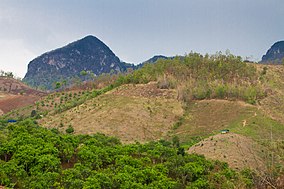|
Si Lanna National Park
Si Lanna National Park (Thai: อุทยานแห่งชาติศรีลานนา) is a national park in Chiang Mai Province, Thailand. Home to waterfalls, caves and springs, this mountainous park is the source of numerous tributaries of the Ping River.[1] GeographySi Lanna National Park is located about 65 kilometres (40 mi) north of Chiang Mai in Mae Taeng, Chiang Dao and Phrao districts. The park's area is 878,557 rai ~ 1,405 square kilometres (542 sq mi).[2] The highest point is Doi Chom Hot peak at 1,718 metres (5,636 ft). The 16 km2 (6.2 sq mi) Mae Ngat Somboon Chon Reservoir lies within the park.[3][4]: 101 HistoryOn 1 August 1989, Si Lanna was designated Thailand's 60th National Park.[1] This national park is home to hill tribes including Karen and Lahu.[4]: 102 AttractionsMon Hin Lai Waterfall is a nine-tiered waterfall located in the Mae Ngat Forest. Other waterfalls include Huai Mae Rangong and Huai Pa Phlu.[5] The Nong Pha cave system features stalactites and stalagmites.[3] Flora and faunaThe park's rugged terrain features numerous forest types: mixed deciduous, moist evergreen, hill evergreen and dipterocarp. Tree species include Tectona grandis, Pterocarpus macrocarpus, Dalbergia oliveri, Hopea odorata, Shorea obtusa, Dipterocarpus obtusifolius, Dipterocarpus tuberculatus, Irvingia malayana, Xylia xylocarpa, Cinnamomum iners, Toona ciliata, Lagerstroemia calyculata and Shorea siamensis.[3] Animal species include tiger, Asian black bear, sambar deer, northern red muntjac, macaque, Siamese hare and wild boar.[3] Bird life includes coucal, bulbul, barbet,[3] little egret and lesser whistling-duck.[4]: 102–103 Location
See alsoReferences
Wikimedia Commons has media related to Si Lanna National Park. |
|||||||||||||||||||||||||||||||||||||||||||||||||||||||||||||||||||||||||||||||||||||


